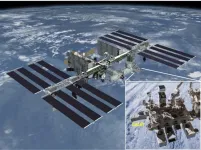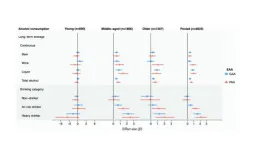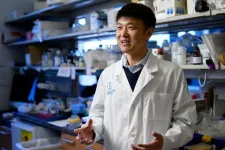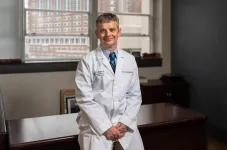(Press-News.org) A new study using data from the CALorimetric Electron Telescope (CALET) instrument on the International Space Station has found evidence for nearby, young sources of cosmic ray electrons, contributing to a greater understanding of how the galaxy functions as a whole.
The study included more than seven million data points representing particles arriving at CALET’s detector since 2015, and CALET’s ability to detect electrons at the highest energies is unique. As a result, the data includes more electrons at high energies than any previous work. That makes the statistical analysis of the data more robust and lends support to the conclusion that there are one or more local sources of cosmic ray electrons.
“This is one of the primary things that CALET is made to look for,” says Nicholas Cannady, an assistant research scientist with UMBC’s Center for Space Sciences and Technology, a partnership with NASA Goddard Space Flight Center, and a leader on the study. With this paper, he adds, “We were really able to push into the realm where we have few events and start to look for things at the highest energies, which is exciting.”
A better understanding of the galaxy
Current theory posits that the aftermath of supernovae (exploding stars), called supernova remnants, produce these high energy electrons, which are a specific type of cosmic ray. Electrons lose energy very quickly after leaving their source, so the rare electrons arriving at CALET with high energy are believed to originate in supernova remnants that are relatively nearby (on a cosmic scale), Cannady explains.
The study’s results are “a strong indicator that the paradigm that we have for understanding these high-energy electrons—that they come from supernova remnants and that they are accelerated the way that we think they are—is correct,” Cannady says. The findings “give insight into what’s going on in these supernova remnants, and offer a way to understand the galaxy and these sources in the galaxy better.”
CALET is a collaborative project built and operated by groups in Japan, Italy, and the United States, led by Shoji Torii. The lead contributors to this work in Japan are Torii, Yosui Akaike, and Holger Motz at Waseda University in Tokyo, and Louisiana State University is the lead institution in the U.S. The findings were published in Physical Review Letters.
New data lead to new cosmic ray sources
Previous work found that the number of electrons arriving at CALET decreased steadily as energy increased up to about 1 teravolt (TeV), or 1 trillion electron volts. The number of electrons arriving with even greater energy was extremely low. But in this study, CALET did not see the expected dropoff. Instead, the results suggest that the number of particles plateau, and then even increase, at the highest energies—all the way up to 10 TeV in a few cases.
Previous experiments could only measure particles up to about 4 TeV, so the highest energy event candidates above that in this study are a crucial new source of information about potential nearby sources of cosmic ray electrons. Cannady led the effort to individually analyze each of those events to confirm they represent a real signal, and a deeper dive into those events is forthcoming.
Addressing challenges
It’s difficult to distinguish between electrons and protons at high energies, and there are many more protons arriving than electrons, which poses challenges to an accurate analysis. To tell the particles apart, a program developed by the researchers analyzes how the particles break down when they hit the detector. Protons and electrons break down differently, so comparing the cascade of particles they create in that process can filter out the protons. However, at the highest energies, the differences between protons and electrons decrease, making it harder to accurately remove only the protons from the data.
To address this, Cannady led the CALET team’s effort to simulate the breakdown patterns of both protons and electrons coming from the exact direction each of the high-energy events arrived from. That increased the team’s ability to determine whether the events are electrons or protons as accurately as possible.
Based on that work, “We believe we are evaluating the likelihood of events being protons in a realistic fashion,” Cannady says. Enough presumed electrons remain in the dataset after that careful analysis to conclude there is a real signal.
Pushing boundaries
T. Gregory Guzik, professor of physics at LSU and the U.S. CALET collaboration lead, is excited that further analysis of the data suggested that electrons coming from the three best candidates for nearby supernova remnants can explain the high-energy arrivals.
“These CALET observations open the tantalizing possibility that matter from a particular nearby supernova remnant can be measured at Earth,” Guzik shares. “Continued CALET measurement through the life of the International Space Station will help shed new light on the origin and transport of relativistic matter in our galaxy.”
For Cannady, “The most exciting part is seeing things at the highest energies. We have some candidates above 10 TeV—and if it is borne out that these are real electron events, it’s really a smoking gun for clear evidence of a nearby source,” he says. “This is essentially what CALET was put up to do, so it’s exciting to be working on this and to finally be getting results that are pushing the bounds of what we’ve seen before.”
END
Study finds strongest evidence yet for local sources of cosmic ray electrons
CALET instrument detects electrons arriving with more energy than ever recorded before
2023-11-14
ELSE PRESS RELEASES FROM THIS DATE:
Special Issue of Criminology & Public Policy examines cybercrime and cybersecurity
2023-11-14
Cybercrime—computer hacking, social engineering, intellectual property theft, electronic fraud, online interpersonal violence, identity theft, and Internet-facilitated sexual victimization—is a leading threat to national security, with millions of victims in both the United States and around the world, and billions of dollars being spent to combat it.
Criminology and related disciplines are just beginning to understand cybercrime and how best to deter and prevent it—or at least reduce its harms. ...
Special issue of Medicare Care supports the need to study economic impacts on patient outcomes
2023-11-14
November 14, 2023 — A special supplemental issue of Medical Care, sponsored by the Assistant Secretary for Planning and Evaluation (ASPE) in the U.S. Department of Health and Human Services, supports the growing recognition that economic factors often affect health outcomes, patient decision-making, and equity in health care. Medical Care, the official journal of the Medical Care Section of the American Public Health Association, is published in the Lippincott portfolio by Wolters Kluwer.
The scope of patient-centered outcomes research (PCOR) was expanded to include economic outcomes in the 2019 reauthorization ...
Alcohol consumption and epigenetic age acceleration across human adulthood
2023-11-14
“Our findings may help to understand the role of alcohol-associated biological aging in the development of age-related diseases such as CVD and cancer.”
BUFFALO, NY- November 14, 2023 – A new research paper was published in Aging (listed by MEDLINE/PubMed as "Aging (Albany NY)" and "Aging-US" by Web of Science) Volume 15, Issue 20, entitled, “Alcohol consumption and epigenetic age acceleration across human adulthood.”
The alcohol-associated biological aging remains to be studied across adulthood. In their new study, ...
How one lab at MSK is working to harness the power of the immune system against cancer
2023-11-14
Investigator Ming Li, PhD, has dedicated his career to understanding the intricate workings of the immune system — both in general and for the critical role it plays in cancer.
Study by study, his lab at Memorial Sloan Kettering Cancer Center (MSK) is sharing new insights into the molecular and cellular mechanisms involved in immune regulation — a type of knowledge-building that scientists call “basic science” or “discovery science.” But Dr. Li is equally focused ...
University of Kentucky researcher helps solve 60-year mystery inside heart, publishes in Nature
2023-11-14
LEXINGTON, Ky. (Nov. 14, 2023) — One University of Kentucky researcher has helped solve a 60-year-old mystery about one of the body’s most vital organs: The heart.
Kenneth S. Campbell, Ph.D., the director of translational research in the Division of Cardiovascular Medicine in the UK College of Medicine, helped map out an important part of the heart on a molecular level. The study titled “Cryo-EM structure of the human cardiac myosin filament” was published online in the prestigious journal Nature earlier this month.
The heart is made up of billions of cells. Each cell contains thousands ...
Melting ice falling snow: Sea ice declines enhance snowfall over West Antarctica
2023-11-14
UNIVERSITY PARK, Pa. — As the world continues to warm, Antarctica is losing ice at an increasing pace, but the loss of sea ice may lead to more snowfall over the ice sheets, partially offsetting contributions to sea level rise, according to Penn State scientists.
The researchers analyzed the impacts of decreased sea ice in the Amundsen Sea in West Antarctica and found the ice-free ocean surface leads to more moisture in the atmosphere and heavier snowfalls on the ice sheet, the team reported in the journal Geophysical Research Letters.
While the additional snowfall is not enough to offset the impacts of melting ice, including it in climate ...
Dangerous bee virus less deadly in at least one US forest, researchers find
2023-11-14
UNIVERSITY PARK, Pa. — This year’s cold and flu season is bringing good news for honey bees: Penn State researchers have found that the deadly deformed wing virus (DMV) may have evolved to be less deadly in at least one U.S. forest. The findings could have implications for preventing or treating the virus in managed colonies, researchers said.
The study, which was recently published in the Proceedings of the Royal Society B, compared rates and severity of DWV in wild honey bees from ...
Using machine learning, existing fiber optic cables to track Pittsburgh hazards
2023-11-14
UNIVERSITY PARK, Pa. — Existing fiber optic cables used for high-speed internet and telecommunications, in combination with machine learning, may be able to help scientists track ground hazards in Pittsburgh. The National Science Foundation awarded a $937,000 grant to a team of Penn State and Carnegie Mellon University (CMU) researchers to further develop the low-cost monitoring approach.
The effort, which is led by Tieyuan Zhu, associate professor of geosciences at Penn State, relies on prior research that shows hazards such as flooding, landslides, sinkholes and leaking pipes can be monitored at a fraction of the cost of existing methods.
The distributed acoustic sensing ...
Downloading NASA’s dark matter data from above the clouds
2023-11-14
Data from a NASA mission to map dark matter around galaxy clusters has been saved by a new recovery system designed by scientists at the University of Sydney. The system allowed the retrieval of gigabytes of information, even after communication failed and the balloon-based telescope was damaged in the landing process.
In April, the Super Pressure Balloon Imaging Telescope (SuperBIT) was launched from Wānaka Airport, New Zealand, suspended under a helium-filled balloon the size of a sports stadium on top of the Earth’s ...
Non-native species likely to continue spreading in North America, Australia and Europe
2023-11-14
Naturalized species, which are not native but have established themselves in new locations, have the potential to spread even further to suitable habitats in many parts of the world, reports a new study by Henry Häkkinen, Dave Hodgson and Regan Early at the University of Exeter, UK, publishing November 14th in the open access journal PLOS Biology.
Understanding and predicting where introduced species will spread is one of the key conservation and ecological challenges of the 21st century. However, we know little about what causes one species to spread rapidly, while another species remains in small, isolated populations for years. In ...
LAST 30 PRESS RELEASES:
Anthropologists offer new evidence of bipedalism in long-debated fossil discovery
Safer receipt paper from wood
Dosage-sensitive genes suggest no whole-genome duplications in ancestral angiosperm
First ancient human herpesvirus genomes document their deep history with humans
Why Some Bacteria Survive Antibiotics and How to Stop Them - New study reveals that bacteria can survive antibiotic treatment through two fundamentally different “shutdown modes”
UCLA study links scar healing to dangerous placenta condition
CHANGE-seq-BE finds off-target changes in the genome from base editors
The Journal of Nuclear Medicine Ahead-of-Print Tip Sheet: January 2, 2026
Delayed or absent first dose of measles, mumps, and rubella vaccination
Trends in US preterm birth rates by household income and race and ethnicity
Study identifies potential biomarker linked to progression and brain inflammation in multiple sclerosis
Many mothers in Norway do not show up for postnatal check-ups
Researchers want to find out why quick clay is so unstable
Superradiant spins show teamwork at the quantum scale
Cleveland Clinic Research links tumor bacteria to immunotherapy resistance in head and neck cancer
First Editorial of 2026: Resisting AI slop
Joint ground- and space-based observations reveal Saturn-mass rogue planet
Inheritable genetic variant offers protection against blood cancer risk and progression
Pigs settled Pacific islands alongside early human voyagers
A Coral reef’s daily pulse reshapes microbes in surrounding waters
EAST Tokamak experiments exceed plasma density limit, offering new approach to fusion ignition
Groundbreaking discovery reveals Africa’s oldest cremation pyre and complex ritual practices
First breathing ‘lung-on-chip’ developed using genetically identical cells
How people moved pigs across the Pacific
Interaction of climate change and human activity and its impact on plant diversity in Qinghai-Tibet plateau
From addressing uncertainty to national strategy: an interpretation of Professor Lim Siong Guan’s views
Clinical trials on AI language model use in digestive healthcare
Scientists improve robotic visual–inertial trajectory localization accuracy using cross-modal interaction and selection techniques
Correlation between cancer cachexia and immune-related adverse events in HCC
Human adipose tissue: a new source for functional organoids
[Press-News.org] Study finds strongest evidence yet for local sources of cosmic ray electronsCALET instrument detects electrons arriving with more energy than ever recorded before






